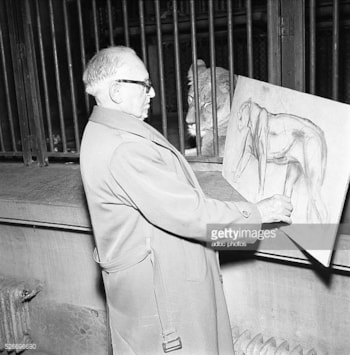
Paul JOUVE
(Marlotte, 1878 - Paris, 1973)

Paul JOUVE
(Marlotte, 1878 - Paris, 1973)
Encouraged by his father, Paul Jouve spent a considerable amount of time during his childhood and youth drawing in Paris' Jardin des Plantes (a botanical garden) and Museum National d'Histoire Naturelle. When he was thirteen, he attended the Ecole des Arts Decoratifs (school of decorative arts) and was soon also accepted to the École des beaux-arts (school of fine arts).
When he was about sixteen years old , he submitted his first work to the Salon, where his drawings of animals gained the attention of the architect Rene Binet; Binet subsequently offered Jouve a job designing the decoration for a monumental door that was installed at the Exposition Universelle held in Paris in 1900. Following this experience, Jouve actively pursued a career as an animalier sculptor, seeking his subject matter in the zoos of Europe and in Northern Africa.
In 1907, with the assistance of a grant from the Society of French Orientalist Painters, Jouve came to reside at the villa Abd-el-Tif in Algiers, which was a sort of French artists' retreat in the African colony of Algeria. Unfortunately, war forced him to leave quite early, but he travelled to Greece and he explored that region instead. After Greece, following World War I, Jouve traveled on to the Far East, visiting places like Ceylon (now Sri Lanka), Saigon (now Ho Chi Minh City) in the French colony of Cochinchine (now Vietnam), and Phnom Penh in Cambodia. Later, he made his way back to explore jungles in Africa.
Throughout his extensive and adventurous travels, Jouve gathered visual references to incorporate into his artwork. Although he preferred sculpting his subjects, Jouve was a consummate artist, portraying exotic animals in watercolour, oil, and drawing media as well. Contemporary sources classify his personal style as Art Deco, though this label may be misleading. Jouve sought to combine the French animalier tradition with newly available "oriental" vocabulary, and was informing this creative endeavour with first-hand experience.
An internationally successful artist in his own time, Jouve is perhaps best remembered today for his depiction of "big cats," and for illustrating an edition of Rudyard Kipling's The Jungle Book in collaboration with the engraver F.L. Schmied (Swiss, 1873-1941). Jouve was elected to the French Academie des Beaux-Arts (Academy of Fine Arts) in 1945. He passed away in 1973.






